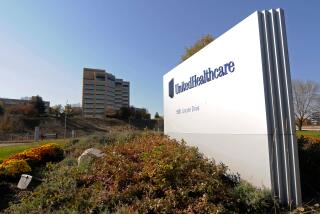Survey suggests website woes not wrecking Obamacare -- yet
- Share via
The journalism hive mind has turned its focus in recent days to the backstory of the disastrous launch of HealthCare.gov, the website for the federal insurance-buying exchange. A survey released Monday by the Commonwealth Fund, however, suggests that the site’s problems haven’t had much of an impact ... yet.
The spate of stories exploring the why’s and who’s behind the botched launch include an exhaustive piece in the Washington Post about how political concerns trumped technical ones in the years after the Affordable Care Act was enacted, as well as an L.A. Times article about President Obama’s shortcomings as a manager. (Red meat sample: “Although unpredictable crises often upend presidents’ second terms, some of Obama’s worst problems seem self-inflicted.”)
There’s also been lots of informed speculation about how few people have signed up for coverage through the exchanges. The only hard data have come from seven of the 16 state-run exchanges, which have reported fewer than 300,000 enrollees -- the vast majority of them in Medicaid, not private insurance plans. The 34 federal-run exchanges aren’t reporting how many people have signed up because, top officials say, they don’t have a reliable way of determining the number. But an unofficial tally shows only six sign-ups on the first day and 248 on the second.
Ouch.
It goes without saying that technical problems have hindered people from obtaining policies through HealthCare.gov and many of the state-run sites. What we don’t know is how different the results would have been had the sites worked perfectly from Day One.
Here’s where the Commonwealth Fund survey comes in. The study was based on interviews last month with 682 adults under age 65 who may need individual insurance coverage (that is, they didn’t have health benefits from the large employer). It found that 60% knew about the exchanges but only 17% had visited one online, in person or by phone. In other words, 5 out of 6 people who would be served by the exchanges had yet to shop there.
Of that 17%, the survey found, one-fifth signed up for insurance. The rest were divided roughly evenly between those who weren’t sure they could afford insurance and those who hadn’t settled on a specific plan. Although 70% of those who visited the exchanges rated the experience as “fair” or “poor,” only about 5% of those surveyed said the websites’ technical problems were a factor in them not enrolling.
So if the survey’s sample is representative of the country as a whole, the real and serious technical problems at the exchanges’ websites are affecting only about 5% of the potential enrollees, even though they’re generating most of the headlines.
That’s consistent with the prediction made in late September by Peter V. Lee, executive director of California’s exchange, Covered California. Lee said consumers would probably make multiple trips to the website to gather information before signing up for a plan. It makes sense intuitively too -- the earlier you sign up for a policy through an exchange, the sooner you’ll have to start paying premiums, even though the policy won’t go into effect until Jan. 1.
Of course, the problems at HealthCare.gov made it hard for people not just to enroll but also simply to gather information. The site requires people to register and go through a financial screening before showing them the details of the coverage that’s available in their area. Its servers had trouble completing those preliminary tasks at first, although those problems have faded with time.
That might explain why more than half of those surveyed who visited the exchanges in person, by phone or online said they had trouble comparing plans or finding policies with the specific type of coverage they were seeking. More than 60% also had trouble finding affordable coverage, although it wasn’t clear from the study whether that was because they had trouble determining the price of policies or because the prices were too high.
The survey also found that almost half of those surveyed who visited the exchanges described themselves as being in “very good” or “excellent” health. The success of the insurance reforms in the 2010 law hinges on the exchanges’ ability to sign up healthy people for coverage. If insurers are stuck covering only sicker, riskier individuals, premiums could spiral upward.
A key question now is whether healthy Americans have much patience for the problems at HealthCare.gov and some of the state sites. The survey didn’t explore that issue directly, although it did find that most of those surveyed hadn’t gotten discouraged yet.
“A majority of survey respondents appear determined to gain coverage over the next few months,” the study’s authors wrote. “Three of five adults (58%) who either had not yet gone to their marketplace or had visited it but not yet enrolled in a plan said they were very or somewhat likely to visit by the end of the enrollment period (March 31, 2014) to enroll in a plan or find out if they are eligible for financial help.”
The Obama administration has said it plans to get HealthCare.gov running smoothly by the end of November. There’s no telling from the survey, though, whether that will be soon enough to render the site’s early difficulties moot.
ALSO:
The grim economics of food stamps
McManus: A plague on both your parties
Obamacare: Unfair to the young middle class, punished enough already
Follow Jon Healey on Twitter @jcahealey and Google+
More to Read
A cure for the common opinion
Get thought-provoking perspectives with our weekly newsletter.
You may occasionally receive promotional content from the Los Angeles Times.







